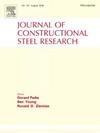输电线路铁塔抗野外火灾能力的计算分析
IF 4
2区 工程技术
Q1 CONSTRUCTION & BUILDING TECHNOLOGY
引用次数: 0
摘要
本文介绍了在火灾事件和伴随的风力作用下对输电塔进行的有限元(FE)分析。分析考虑了几个关键方面(包括与温度相关的非线性材料特性、几何非线性、单腿螺栓连接造成的构件偏心,以及轴向和旋转方向上与温度相关的连接行为)。FE 模型还使用了 Abaqus 中的显式求解器进行准静态分析。现实火灾事件中的构件温度变化是根据火灾强度和由此产生的垂直气体温度分布分析得出的,因此可以将现实野外火灾的影响作为构件温度曲线输入。首先,根据案例研究结果,从最关键的加热和风力模式以及受火灾影响高度的影响等方面提供火灾设计指导。然后,进行了进一步的火灾分析,以研究最关键的火灾情况,并评估塔楼在实际火灾事件中的脆弱性。最后,对常用的喷涂隔热材料及其在灾难性野外火灾事件中降低构件温度和保持极限强度的有效性进行了评估。有限元模拟结果表明,45 度风和部分侧面加热会导致整体强度的严重下降,而火灾高度的影响则不太明显。就火灾情况而言,火灾持续时间越长,风速越慢,对耐火性/等级的影响就越大。本文章由计算机程序翻译,如有差异,请以英文原文为准。
Computational analysis of wildland fire resistance for transmission line tower
Finite element (FE) analysis of the transmission towers under a fire event and the accompanying wind is presented. Several key aspects (including temperature-dependent non-linear material properties, geometric non-linearity, member eccentricity due to the single-leg bolted connection, and the temperature-dependent connection behaviour in both the axial and the rotational directions) are considered. A quasi-static analysis is also employed in the FE model using the explicit solver available in Abaqus. The member temperature variation during a realistic fire event is derived analytically based on the fire intensity and the resultant vertical gas temperature distribution so that the effect of the realistic wildland fire can be input as a member temperature profile. First, fire design guidance in terms of the most critical heating and wind pattern, as well as the effect of fire-affected heights are provided based on the case study results. Then, further fire analysis is carried out to investigate the most critical fire scenario and to evaluate the vulnerability of the tower during a realistic fire event. Lastly, an evaluation of a commonly used spray-on thermal insulation and its effectiveness in reducing the member temperature and preserving ultimate strength during a catastrophic wildland fire event are presented. The FE simulations revealed that a 45-degree wind associated with partial side heating leads to a more critical degradation of the overall strength, whereas the effect of fire height is less obvious. In terms of the fire scenario, a longer fire duration associated with a slower wind is more critical for the fire resistance/rating.
求助全文
通过发布文献求助,成功后即可免费获取论文全文。
去求助
来源期刊

Journal of Constructional Steel Research
工程技术-工程:土木
CiteScore
7.90
自引率
19.50%
发文量
550
审稿时长
46 days
期刊介绍:
The Journal of Constructional Steel Research provides an international forum for the presentation and discussion of the latest developments in structural steel research and their applications. It is aimed not only at researchers but also at those likely to be most affected by research results, i.e. designers and fabricators. Original papers of a high standard dealing with all aspects of steel research including theoretical and experimental research on elements, assemblages, connection and material properties are considered for publication.
 求助内容:
求助内容: 应助结果提醒方式:
应助结果提醒方式:


